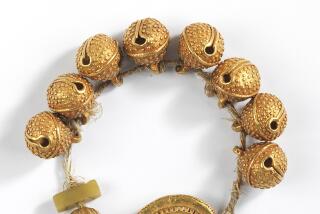Touch of Evil
- Share via
“Listen to the yell of Leopold’s ghost / Burning in Hell for his hand-maimed host. . . . “
That was Vachel Lindsay’s epitaph for Leopold II, king of the Belgians and king-sovereign of the Congo Free State. When he died in 1909, he was the most execrated ruler on Earth. Three years earlier, he had been forced by world opinion, led by the great campaigner Edgar Morel, to hand over his gigantic central African colony, run as his own private possession, to the Belgian state. The horrors of the Congo rubber boom, symbolized by the practice of severing the hands of Africans who failed to meet their wild-rubber quota, were part of the consciousness of right-minded people throughout Europe and North America. And yet the whole episode was soon to slip out of memory as if it had never taken place. The Royal Museum of Central Africa at Tervuren, outside Brussels, is dedicated to Leopold’s memory and contains no hint of the immense atrocity which made the Congo “Free State” possible.
Reading a book on a plane trip, Adam Hochschild was struck by a footnote to a remark by Mark Twain that mentioned that 5 to 8 million people had died as a result of Leopold’s regime in the Congo Free State. Could this be true, and why had he never heard about it before? “King Leopold’s Ghost,” the result of years of investigation, concludes that the figure must be roughly correct. The first census in the colony in the 1920s revealed a population of about 10 million, and all the evidence from the Free State period--from its foundation in 1885 to its surrender to Belgium in 1906--suggested that the population in those years had been reduced by half. Outright murder and massacre by soldiers, starvation and exposure, disease whose impact was multiplied by the uprooting of whole communities and by hunger and a collapse of the birthrate during decades of mounting terror were the causes. How then could the world--once obsessed with the cruelties of “Red Rubber” in the Congo--have forgotten so completely?
There are many answers. One is World War I: The German invasion of neutral Belgium, only six years after Leopold’s death, transformed that country’s image into “plucky little Belgium.” National guilt about the Congo was purged. Other empires, like the British, were happy to forget practices in the Congo, forced labor above all, which resembled what they did in their own colonies. And the African people of the Congo, who had the greatest right to commemorate their own sufferings, were securely gagged by Belgian colonialism. Congolese independence, when it arrived in 1960, soon fell into a shambles of dictatorship; the nightmare of the Free State was never built into a new national mythology.
And yet, as Hochschild’s brilliant book demonstrates, the great Congo scandal prefigured our own times. It was the first Orwellian big lie, which sold a gigantic mechanism of greed and terror to the world as a crusade for humanitarian values. A Newspeak was devised in which everything became its opposite--until Free State officials could write unself-consciously in their official reports about “volunteers in chains” and “liberated men chained by the neck.” It was the first modern public relations war, fought out by Leopold with the familiar armory of payments to selected journalists and politicians (including bribes to the U.S. Senate Foreign Relations Committee), pseudo-conferences for high-minded idiots on such topics as “How Civilization Can Be Brought to Africa” and the enlistment of big business figures as lobbyists. On the other side, opposing Leopold’s terror, the Congo Reform Association set up by Morel and Roger Casement was, as Hochschild says, “the first major international human rights movement of the 20th century.” In its brief life, between 1904 and its dissolution in 1913, the association showed that a single-issue lobby could shape and mobilize public opinion on a global scale and seize the world’s emerging middle-class conscience.
Leopold’s underlying aim was to construct a new sort of monarchy suitable for the 20th century. He concluded that the modern monarch must also be the greatest capitalist in the land, possessing a huge personal fortune immune to state control and steering economic development through his own participation in all major corporations and trusts. Unlike neighboring Holland, Belgium possessed no colonial empire. But Leopold’s studies convinced him that it was only the profits from colonial raw materials, exploited by monopolistic concessions in which the king was the major shareholder, that could provide the independent dynastic fortune his vision required. This astonishing idea eventually came to nothing; the idea of “The King Inc.” as royal tycoon did not survive Leopold’s loss of the Congo. Royals in our own time prefer to spend their fortunes on harmless trinkets like yachts, horses and stamp collections. The Congo Free State remains a hideous but isolated experiment in “new monarchy.”
Leopold contrived to deceive the entire world about his intentions. He persuaded Europe and the United States that he was establishing an international zone in the Congo basin. There, his agents would rescue the inhabitants from the Arab slave trade, bring them education and “civilization” and create a guaranteed free-trade area in central Africa open to the traders of all nations. The world powers were easily duped and swindled and, at a series of conferences, hailed Leopold as a mighty humanitarian visionary.
It was all lies. Leopold’s Congo, advertised in the United States as the seed of a future “confederation of free negro republics,” was in reality a tightly centralized colony designed to strip the territory of natural wealth. Free trade in the Congo was a myth, although it took the outside world years to find that out. The Arab slavers were replaced by a far more destructive and all-embracing system of slavery. Forced labor was at the heart of the process, as Belgian officers used military terror to round up whole communities and set them to work on building the infrastructure. Ivory and then wild rubber were extracted by a merciless quota system imposed on villages; resistance was met by the kidnapping of women and children and by atrocities like the practice of amputating hands. “Vacant” land was declared crown property, although these were customarily community lands vital to the survival of African rural life. As the whole social fabric began to collapse, threatening to reduce the deliveries of ivory and rubber, the state resorted to punitive expeditions and wholesale slaughter. But given that this economy had practically no production costs apart from bullets, the concession companies and Leopold himself continued to make enormous profits.
There are several heroes in this book. The finest is Morel, the young shipping clerk in Antwerp who carefully deduced from what he saw at the docks that the Congo was not what it professed to be. He noted the huge consignments of ammunition being loaded for the Congo. He brooded on the discrepancy between the value of goods being exported there from Belgium--articles mostly unsuitable for trading--and the value of the African cargoes coming off the ships at Antwerp. Plainly, this inrush of ivory, rubber and copal had not been acquired by money or barter. How then?
There was only one possible conclusion. Morel was looking at a system that extracted wealth not by exchange but by force, not with cash but with bullets. He began to ask awkward questions. “I had stumbled on a secret society of murderers with a King for a cronyman.”
Morel was one of the very few truly good men who achieved influence in the 20th century. He was fearless, burning with energetic indignation against injustice. He was a genius of communication who used his talents as a journalist, researcher and correspondent (he wrote up to 7,000 letters a year at the height of the Congo agitation) and the charisma of his own obvious honesty to win battles against all the resources that wealth and reaction could command.
After his revelation at Antwerp, he went on to build the most successful lay campaigning machine the world had ever seen, the Congo Reform Assn. His stoutest ally and close friend was Casement, the future martyr for Irish independence, whose report to the Foreign Office as vice consul in the Congo gave the organization its first breakthrough.
Morel looked beyond the effects to the causes; he saw that the twin roots of evil at the heart of darkness were not original sin and human greed but forced labor and the refusal to recognize African rights to land. His analysis was far ahead of its time. One of the real triumphs of “King Leopold’s Ghost” is that Hochschild also rescues Morel’s remarkable precursors from oblivion: two black American churchmen, George Washington Williams and William Sheppard, who saw the truth about King Leopold’s Congo for themselves and tried to warn the world.
Williams, a pastor and journalist who had fought in the Civil War, at first admired what he understood of Leopold’s project. A visit to the Congo disillusioned him. In 1890, only five years after the Congo State had been granted recognition, he brought out the first comprehensive attack on the Congo as a system. His “Open Letter” to Leopold stated baldly: “Your Majesty’s government is engaged in the slave-trade, wholesale and retail. It buys and sells and steals slaves.” This was a direct hit that created panic in Brussels, but Williams died of tuberculosis the following year, and his evidence was brushed under the carpet. Sheppard, a vigorous young missionary, was the first foreigner to visit the capital of the BaKuba people and to record that society while it was intact. A few years later, he saw it smashed and massacred by the soldiers of one of the rubber companies. The company sued Sheppard for his exposure of these horrors, but the great Belgian socialist Emile Vandervelde went to the Congo to defend him, and the case was dismissed.
In his 1903 diary, Casement scribbled: “Infamous! Infamous, shameful system. . . .” But Joseph Conrad in “Heart of Darkness” saw even further; he stared into the souls of the white men who murdered and tortured for the system and believed that they were civilizers. He gave to literature the character of Kurtz, the insane aesthete who fenced his house with skulls and, at the end of his lofty report on the suppression of savage customs, scrawled: “Exterminate all the brutes!” Hochschild argues, with some good evidence, that the original Kurtz was the sinister Capt. Rom, whose inner station far upstream really was decorated with skulls on stakes. But Conrad was a seer. He modeled his characters on people who had not yet been born, the cultured men with dual minds who were to run Auschwitz and the Gulag.
That is why this book must be read and reread. In its breathtaking mendacity, in its shameless industry of lies, in its elevation of sadism and greed into a civilized routine, the Congo Free State was a testing-ground for the 20th century. Kurtz, for a time, ruled most of the world. We must never forget that again.
More to Read
Sign up for Essential California
The most important California stories and recommendations in your inbox every morning.
You may occasionally receive promotional content from the Los Angeles Times.










